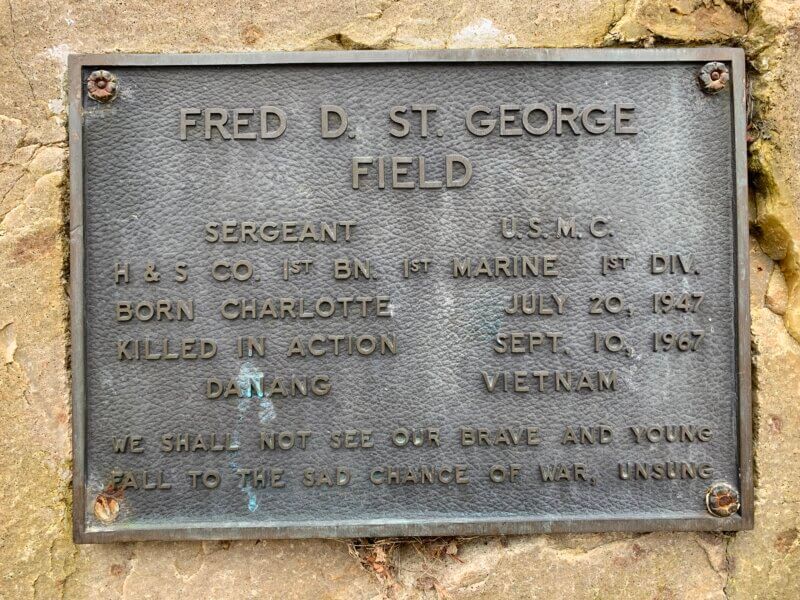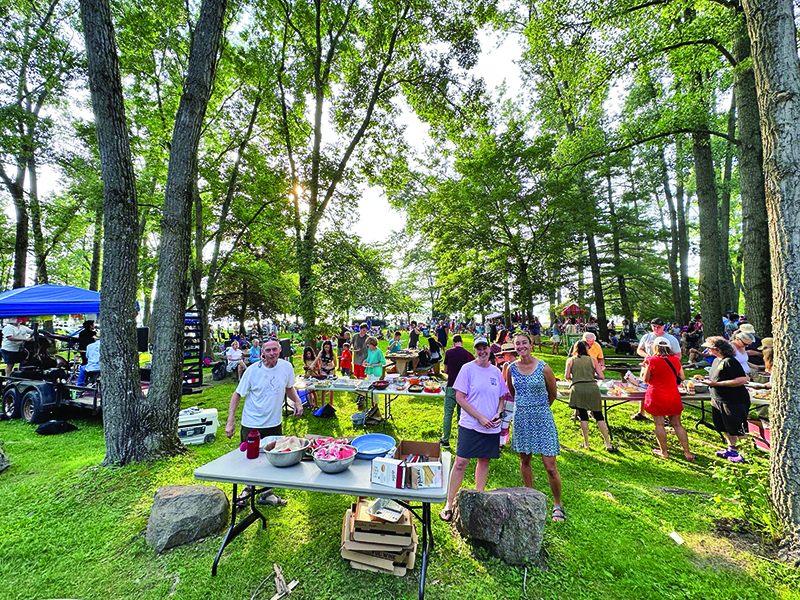The origins of the Charlotte Town Beach
An inquiry about our beach was received recently from Dick St. George posing several questions, including our inability to restrict beach access to Charlotte residents.
Let’s look at the origins of the beach and surrounding park that have become an integral part of our town. The road is not where it originally was, but that’s another story.
Was the land donated?
No. The beach area with some land on the east side of the road for parking had been leased from Richard Thurber for $1 per year for many years with the town paying for upkeep and maintenance.
Tom Larson recalls the raft being opposite the current northernmost stairs, with a narrow dirt road access to the beach allowing his father’s tractor to drag the raft out of the lake at season’s end.

This memorial to Marine Sgt. Fred David St. George, Charlotte’s only resident to be killed in the Vietnam War, is at the Charlotte Town Beach. Fred St. George’s senior photo from the 1965 “Janus,” the Champlain Valley Union High yearbook.
The town approved ending the lease arrangement at a special town meeting held July 8, 1970, potentially expanding use of the east side of the road. Negotiations were finalized in February 1971. The town purchased 800 feet of shoreline and 6 acres of land from Mr. and Mrs. Richard Thurber for $20,000 and 80 feet of shoreline and 12+ acres of land from Mr. and Mrs. Walter Larson for $20,000.
To finance a portion of the $40,000 purchase price, $5,000 was withdrawn from a development fund established by Harry Webb of Shelburne. The selectboard pursued outside funding to avoid another capital expense on the town budget; however, there was a caveat.
The town got $20,000 from the federal Bureau of Outdoor Recreation and $15,000 from state’s recreational fund. Because the town accepted state and federal funds, the beach could not be restricted to Charlotte residents but could be controlled by the town.
A committee was tasked with creating a plan to develop the beach area. An initial plan was put forward to cost about $25,000, but stalled in 1973 when several Charlotte residents argued the proposed recreation area should be at the school. Others pushed for a new committee and plan, which threatened the arrangement with the Bureau of Outdoor Recreation due to a deadline for the funding allocation.
Several town committees got together and hammered out a more comprehensive revised multiphase plan for the beach costing $115,386, which was approved at the 1974 town meeting.
A solicitation for bids was placed in the newspapers throughout the summer of 1976, and another request for $39,000 in funding was made to launch the project. The town got this money with a reimbursement of $12,580 from the Bureau of Outdoor Recreation and the Vermont Recreation Department Act; state assistance of $8,806; and the town share of $3,774.
The plan included a swimming dock, upgraded rafts and stairs, lifeguard facilities, beach equipment, a beach house, two tennis courts, a parking lot for 60 cars, riprap to stabilize the shoreline, planting of new trees, parking lot lights, a raised area for picnic and general usage, diversion ditches and a fenced-in children’s play area with equipment.

Charlotte celebrated its annual town party at the town beach on Saturday. (2023)
Paul Marcotte, chair of the Charlotte Parks and Recreation Committee and experienced employee of Pizzagalli Construction, volunteered to supervise the work. As the park developed, it became apparent that it would evolve into a crucial space for our community.
It was resolved in 1981 that the park and beach honor Marine Sgt. Fred David St. George, the only Charlotte resident to be killed in Vietnam, and arrangements were made to dedicate the renovated and expanded town park to his memory. On July 4, 1982, 250 people gathered there for the official ceremony.
St. George, a member of the first graduating class of Champlain Valley Union High in 1965, was killed in action on Sept. 10, 1967, in Quang Nam Province only weeks before his tour of duty would have ended.
Son of David and Ruth (Thorpe) St. George, his father had predeceased him in 1963. At the time of the Burlington Free Press article describing the dedication, his mother seemed not to have accepted his death and kept looking for him to come home. His mother died in 1973. Here is a link to the Vietnam Veterans Memorial virtual wall with his dedication: virtualwall.org/ds/StgeorgeFD01a.htm. (You will notice he is listed as a Hinesburg resident because at that time rural mail delivery, before enhanced 911 addressing, gave him, and others who lived in that part of East Charlotte, a Hinesburg address.)
Sen. Patrick J. Leahy was the keynote speaker. There was an honor guard provided by the U.S. Marine Corps. The blessing and dedication of the park was made by Monsignor John Fradet.
Such memorials do not glorify war; they honor the soldiers and their families. One would be hard-pressed to get a greater denunciation of war than from most of the soldiers who fought in one; or, as Renaissance theologian Desiderius Erasmus wrote in the 16th century: “War is delightful to those who have no experience of it.”
It begs the question: Why isn’t the beach area officially identified as the “Fred St. George Memorial Park”?
